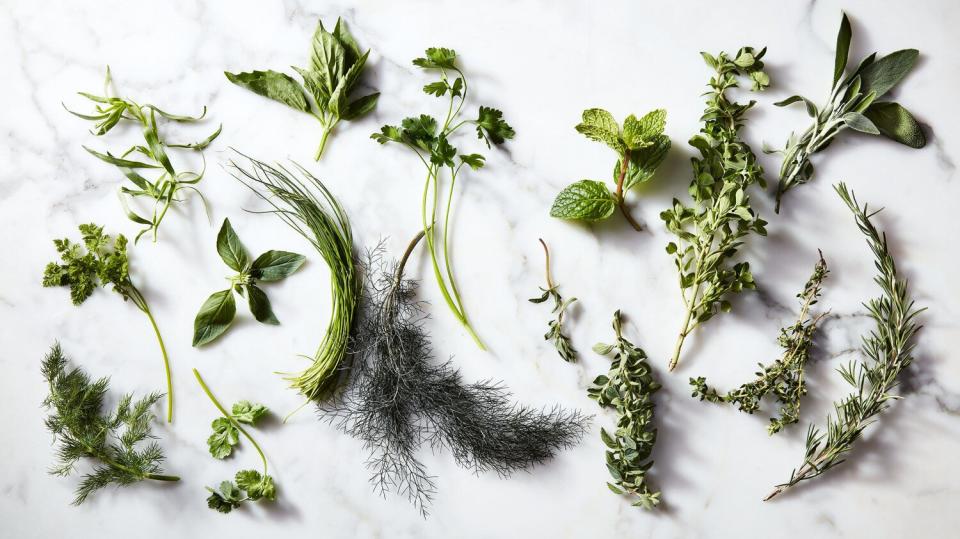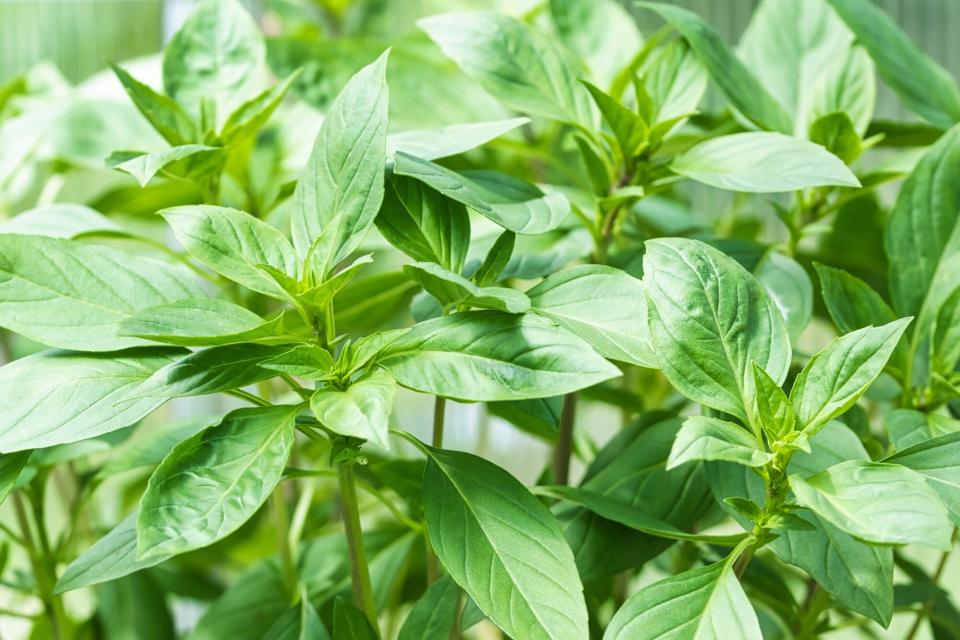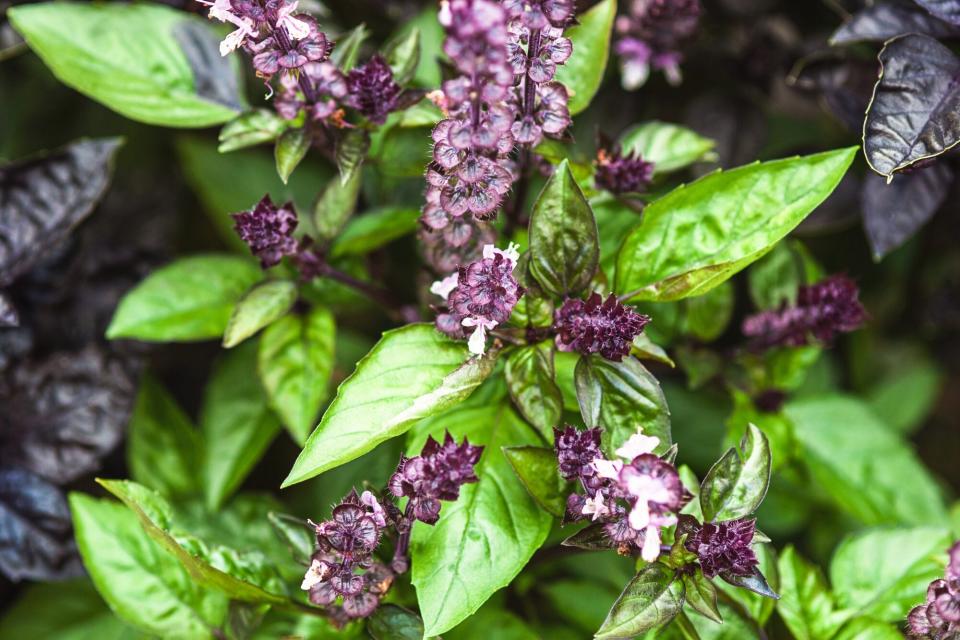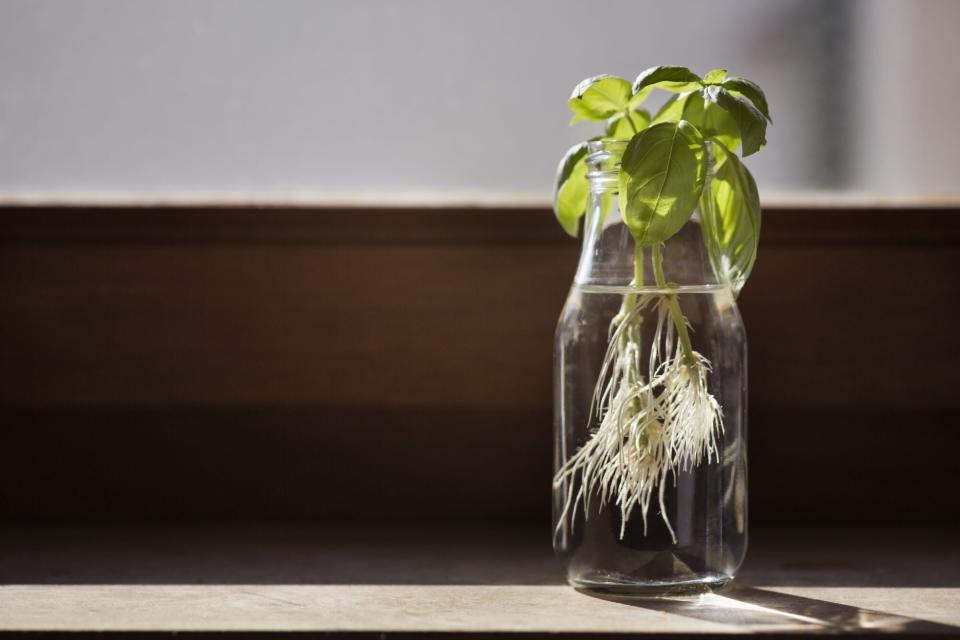How to Grow and Care for Basil Plants, a Summer Annual You Need in Your Culinary Garden
TABLE OF CONTENTS
On This Page
Types of Basil
Planting
Growing
Pruning
Propagating
Repotting
Harvesting
Common Problems
All a basil plant needs is sun, water, and a bit of pruning in order to grow long, luscious, and aromatic leaves. Basil comes in several varieties, from sweet to spicy, and it can be found in shades like dark green and deep purple. Because basil is an annual plant (meaning it lasts just one season), you can try out a few different varieties every year.
Related: A Guide to Growing Kitchen Windowsill Herbs

Christopher Testani
Popular Types of Basil
If you're looking for a diverse plant to grow, put basil on your radar—you have so many species to choose from, notes Brie Arthur, a horticulturist and author of The Foodscape Revolution and Gardening with Grains. "There are 60 different species of basil, all of which thrive in sunny, hot conditions and are frost sensitive," says Arthur. "Most basil plants bloom with long days, from July to September in the northern hemisphere." No matter the type of basil, the plants' small flowers stalks can influence the flavor of the leaves (which is why pinching them off is commonly recommended) and almost all iterations thrive in hardiness zones of 10 to 12.
These are some of the most common basil varieties to grow:

Ewa Saks / GETTY IMAGES
Thai Basil
O. basilicum var. thyrsiflora, commonly known as the Thai basil plant, is found in Southeast Asia and Vietnam in particular, says Sabine H. Schoenberg, the host of Sabine's New House on Smart Healthy Green Living. "It has a licorice, anise-like fragrance and is commonly used in stir-fry dishes in Asia," she says. "The leaves are slightly serrated and have purple stems."

GETTY IMAGES
Genovese Basil
If you love to cook with basil, then you've likely come across this popular variety: Genovese basil, which is also called sweet basil. "The large, flavorful leaves are ideal for eating both fresh and dried and provide the traditional essence of Italian cuisine," says Arthur. "This species is native to central Africa and is used worldwide." The slightly curled leaves produce a sweet and slightly spicy flavor, adds Schoenberg, noting that it's notably featured in pesto and other pasta dishes.

GETTY IMAGES
Lemon Basil
In contrast to other common basil varieties, Ocimum africanum, often referred to as lemon basil, is a "hybrid" option for gardening and cooking purposes. It has elongated oval shape leaves and a sweet, tangy flavor (hence the name!), says Schoenberg. "One of its biggest advantages is being undesirable to browsing animals such as deer and rabbits," says Arthur. "Lemon basil adds a punch of taste when used fresh in dishes and can also be added to flavor water and tea."

Nadya So / GETTY IMAGES
Cinnamon Basil
Growing this basil type will benefit your baking. "Cinnamon basil, also commonly referred to as 'Mexican spice basil,' has a cinnamon-like, spicy fragrance," says Schoenberg. "It is found in teas and baked goods for its cinnamon flavor." This variety stands out from the pack thanks to its leaves, which are narrow with reddish-purple veins.

GETTY IMAGES
Holy Basil
Similar to Thai basil, Holy basil, which is also called Tulsi, is known for its sweet anise flavor, notes Arthur. Formally called Ocimum tenifolium, there are four types of this basil type: Rami, Krishna, Amrita, and Vana, collectively known as the "queen of herbs" for their healing powers, she adds. These attract pollinators and also have green-and-purple foliage and shiny leaves.
Related: Here's How Long Fresh Herbs Last—Plus, How to Store Them Properly

istetiana / Getty Images
How to Plant Basil
Planting basil at the right time of the year is crucial to its growth. Since the herb thrives in warm temperatures, plant it outside after your last spring frost. If you're growing plants from seeds indoors, start them six to eight weeks before planting them outside, says Melinda Myers, gardening expert, author, and host of the Great Courses' "How to Grow Anything" DVD series.
For basil to grow well, it needs six hours of sun a day, so take a good look at your yard to see where it's the sunniest, according to the New York Botanical Garden (NYBG). If you don't have a yard, plant basil in a container and put it near a window where it has access to lots of sunlight.
How to Grow and Care for Basil
Plant seeds directly in the ground or in raised beds or containers. Spacing plants correctly is essential to healthy growth, says Myers; you can find this information on seed packets or tags that accompany seedlings (young plants that a nursery started from seeds). A good rule of thumb is to space seedlings about one foot apart in the garden bed, notes the NYBG.
Soil
Basil likes rich, organic soils whether you're planting in the ground, a raised bed, or a container," says Myers. To improve your in-ground garden soil, she says to add compost rather than purchased topsoil, which often contains a lot of weed seed and could actually be worse than your existing soil. If you do buy soil, look for a blend of topsoil and compost.
As for potting mix—which you fill containers with—use an organic combination that includes some compost, as well as peat moss and rice hulls for drainage, Myers recommends. Another good option is a mix of coir, peat moss, and perlite.
Watering
Make sure to water your basil plants regularly, since they can suffer in dry conditions. "Through the heat of the summer, I water my potted basil plants daily," says Arthur. "The leaves will 'flag' or droop, indicating they need a drink."
Fertilizing
Apply a slow-release organic fertilizer when planting your basil and then add a liquid feed of kelp meal once a month, Arthur suggests. "That will provide all the macro and micronutrients the basil needs to thrive," she says. "It is important to recognize that synthetic fertilizers (both time-release and water-soluble 'blue stuff') often have high rates of nitrogen, which causes the plants to flush soft new growth, attracting pests like aphids." To avoid this issue, opt for low rates (under 5) of organic fertilizer with nitrogen, phosphorous, and potassium (NPK) ratios.
How to Prune Basil
When tiny flowers begin to grow on your basil plants, or your plants reach more than 6 inches in height, it's time to start pruning. Just remove the flowers and leave the stems alone, says Mark Whittier, color and foliage merchant at Pike Nurseries.
Stay on top of pinching off the flower buds as soon as they appear: "Prune or harvest frequently to keep the blooms at bay and prevent the stems from becoming woody. Once stems become woody, the basil becomes bitter and past its prime," Whittier says. When pruned often, basil can yield an ongoing supply of leaves, according to the NYBG. It's best to cut—not pull—enough of the stem to leave only two to four leaves on the plant.

Elva Etienne / Getty Images
How to Propagate Basil
It is possible to plant a cutting into wet soil, but Schoenberg likes to take a cutting and place it into a glass of water.
Here is Schoenberg's best method for propagating basil:
Keep the glass in a sunny spot and wait for roots to develop in the glass.
Once the roots are at least 1 inch in length, the cutting is ready to transplant into soil.
Keep the soil moist (not waterlogged) for about a week, then slowly reduce the water.
How to Repot Basil
Repotting basil ensures the plants don't become root bound. "My rule of thumb is to pot up basil in midsummer (from July through August) to extend its life through the entire frost-free growing season," says Arthur.
Follow Arthur's best practices to repot:
Remove the plant from its existing pot and move it into a larger container or into the ground.
To eliminate transplant shock, keep the same soil so the roots will start growing easily again, says Arthur.
Do a "hard prune" by cutting the branches back to a lower leaf, which will stimulate new growth and generate the freshest basil clippings possible.
Pro tip: "Never compact the soil by pressing down on the roots," says Arthur. "Instead, tap the container to settle the soil evenly and water thoroughly before placing a sunny area."
Related: 10 Reasons to Grow Your Own Healing Herb Garden
How to Harvest Basil
Cut the stems down as far as needed to get enough leaves for harvest, says Whittier. "Cut just above a node—where the main stem meets two side stems—for the most attractive leaves to use on salads, sandwiches, and pizzas. Pick off the lower leaves for drying and cooking," he says. Harvest in the morning for peak flavor.
Drying
Wipe off dirt and debris and tie in bunches of three to five stems, says the NYBG. Hang it upside down in a dark, warm place, and the basil will be dried within two to four weeks.
Storage
Keep just-cut basil fresh, and don't wash or refrigerate it; instead, tie a few stems together and place in a glass of cold water on a countertop without leaves touching the water, according to the NYBG. You can also freeze basil leaves: Though they'll turn dark, the basil won't lose any of its robust flavor.
Common Problems With Basil
Basil performs best in warm conditions with evenly moist soil, especially when potted into containers. However, some issues may arise. Here are the most common problems you may come cross as you grow basil—and how to remedy them.
Pests
Aphids, slugs, and snails are pests that commonly feed on basil. There's a quick way to keep them at bay: Lightly spray natural insecticidal soap, says Arthur. Avoid using chemicals to remedy pest infestations, as they could affect the flavor of the plants.
Fungus
If you see mold, a mildew infection is likely spreading. This usually occurs through contaminated seeds or infected transplants. When you spot the disease, cut off effected leaves and stems.
Yellowing
Yellowing leaves are the result of overwatering and typically appear at the bottom of the plant. If you see a yellow leaf, simply cut it off. "In general, water basil less and keep things on the drier side," says Schoenberg. "As a general guideline, water basil when the top 1 to 2 inches of soil is dry."

